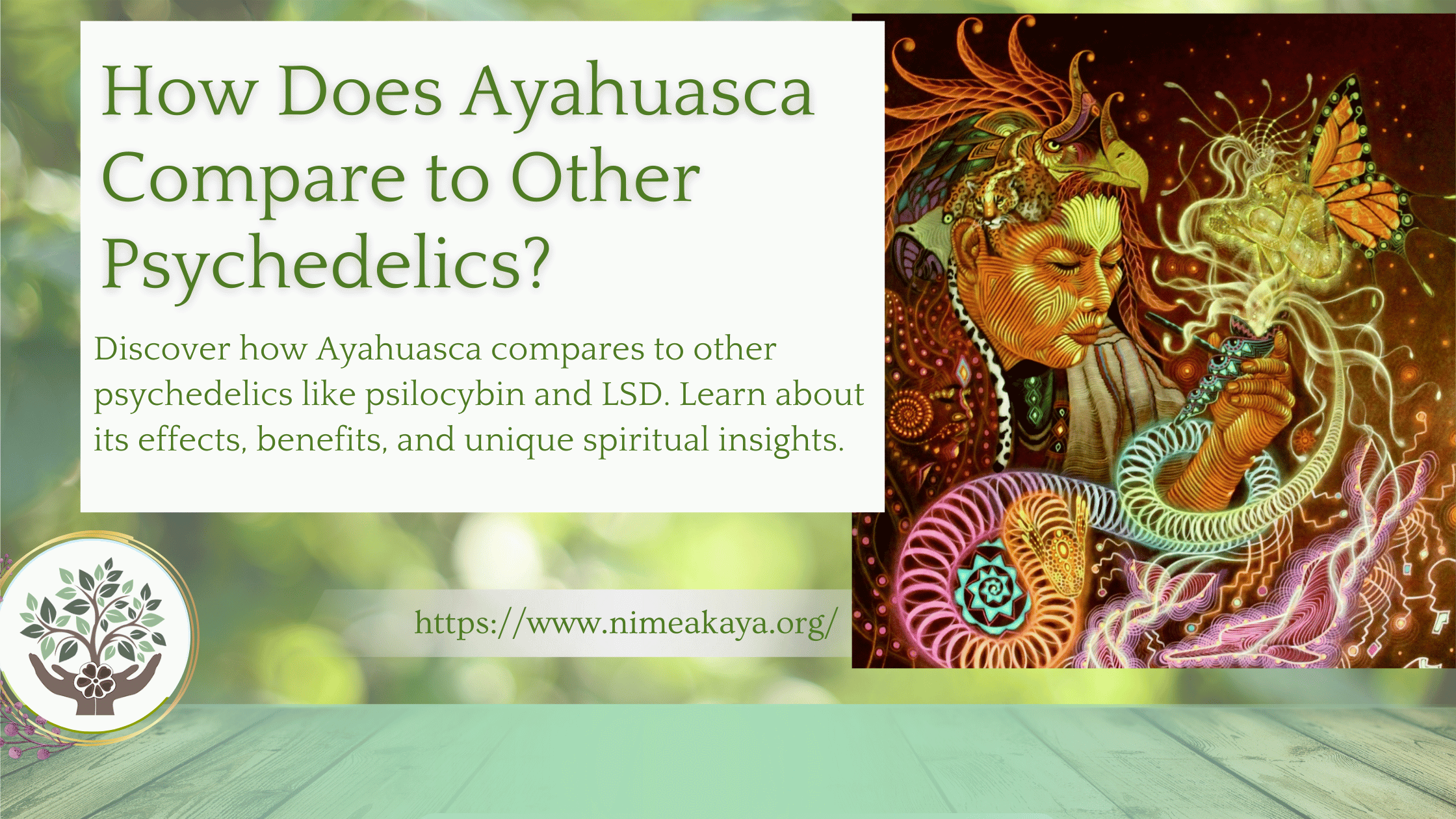How Does Ayahuasca Compare to Other Psychedelics?
Psychedelics have gained increasing attention in recent years for their potential in spiritual awakening, psychological healing, and personal transformation. Among them, Ayahuasca stands out as a sacred plant medicine with deep-rooted traditions in indigenous Amazonian cultures.
But how does it compare to other well-known psychedelics such as LSD, psilocybin (magic mushrooms), DMT, and MDMA? Let’s explore the key differences in effects, experiences, benefits, and risks.
What is Ayahuasca?
Ayahuasca is a brew made from the Banisteriopsis caapi vine and the leaves of the Psychotria viridis plant, which contains DMT (dimethyltryptamine), a powerful hallucinogenic compound. The vine contains MAO inhibitors, allowing the DMT to become active when ingested orally.
Traditionally, Ayahuasca is used in ceremonial settings guided by shamans in South America.
Comparing Ayahuasca to Other Psychedelics
Ayahuasca vs. LSD (Lysergic Acid Diethylamide)
Chemical Composition and Effects:
Ayahuasca’s primary active component is DMT, combined with MAOIs that extend the experience. LSD (lysergic acid diethylamide) is a synthetic psychedelic that primarily affects serotonin receptors, leading to enhanced perception, intense visuals, and changes in thought patterns.
Duration and Control:
Ayahuasca ceremonies last about 4–6 hours and often involve guided experiences with a shaman. The brew can induce powerful, sometimes overwhelming emotions and visions, making guidance crucial.
LSD trips last significantly longer—8 to 12 hours—and offer a more controllable experience. Unlike ayahuasca, LSD does not typically induce physical purging, and users often report being more able to navigate their experiences with intention.
Setting and Use:
Ayahuasca is traditionally used in ceremonial settings with trained facilitators. It is deeply connected to spiritual and shamanic traditions. LSD, while sometimes used in therapeutic settings, is more often taken recreationally or for personal exploration outside of a structured environment.
Ayahuasca vs. Psilocybin (Magic Mushrooms)
Origin and Composition:
Ayahuasca is a sacred brew traditionally used by indigenous Amazonian communities. It is prepared by combining the Banisteriopsis caapi vine, which contains MAO inhibitors (MAOIs), with the Psychotria viridis leaves, which contain dimethyltryptamine (DMT). This combination allows DMT to become orally active, leading to an intense visionary experience.
Psilocybin mushrooms, commonly known as magic mushrooms, contain psilocybin, which the body converts into psilocin. This compound interacts with serotonin receptors in the brain, producing altered states of consciousness and introspection.
Experience and Duration:
An ayahuasca experience typically lasts between 4 to 6 hours and is often characterized by intense visions, emotional processing, and physical purging (vomiting or diarrhea), which is considered a form of spiritual cleansing.
In contrast, a psilocybin journey lasts about 4 to 6 hours but is usually milder, with more fluid, dreamlike imagery. While some individuals report emotional breakthroughs, the experience is often gentler compared to the deep, sometimes challenging introspection of ayahuasca.
Healing and Therapeutic Use:
Both ayahuasca and psilocybin have shown promise in the treatment of depression, anxiety, and PTSD. Ayahuasca is known for its profound emotional and psychological healing effects, often helping individuals confront past traumas. Psilocybin, on the other hand, is being widely researched for its ability to alleviate treatment-resistant depression and anxiety, often with fewer physical side effects.
Ayahuasca vs. DMT (N,N-Dimethyltryptamine – Smoked/Vaped DMT)
Key Differences:
- Both ayahuasca and synthetic DMT contain the same active compound—dimethyltryptamine. However, the methods of ingestion and experiences differ significantly.
- Smoked or vaporized DMT produces an extremely rapid and intense experience, lasting only 5 to 15 minutes. It is often described as being “shot into another dimension” with vibrant geometric visuals and encounters with perceived entities.
- Ayahuasca, on the other hand, provides a much longer and more integrated journey, allowing participants to process their visions with deeper introspection.
Depth of Healing:
- Smoked DMT can be profoundly mystical, but its short duration makes it less suited for in-depth healing and integration. Ayahuasca, by contrast, allows for sustained emotional and psychological exploration, often with the support of trained facilitators.
Ayahuasca vs. MDMA (Ecstasy)
Emotional Effects:
Ayahuasca often brings deep emotional release, requiring individuals to confront suppressed emotions, traumas, and fears. This process can be challenging but is often described as profoundly healing.
MDMA, commonly known as ecstasy, is classified as an empathogen. It enhances feelings of love, connection, and emotional openness, making it particularly useful in therapeutic settings for PTSD treatment. However, it does not produce the same level of visionary experiences as ayahuasca.
Therapeutic Potential:
MDMA is currently being studied for its effectiveness in treating PTSD by allowing individuals to revisit traumatic experiences with reduced fear and increased emotional safety.
Ayahuasca, though less studied in clinical environments, is widely used in spiritual and therapeutic contexts to facilitate deep healing and personal transformation.
Risks and Considerations
- Physical Effects: Ayahuasca often induces vomiting, sweating, and diarrhea, which are seen as part of its healing process. Other psychedelics rarely have such strong physical purging effects.
- Mental Health Risks: While Ayahuasca and other psychedelics can be profoundly healing, they are not suitable for individuals with a history of schizophrenia or severe mental disorders.
- Legality: Ayahuasca is illegal in many countries except for religious or traditional use, while LSD, psilocybin, and MDMA are also restricted substances in most places.
- Guidance & Preparation: Unlike many psychedelics that are used recreationally, Ayahuasca is almost always consumed under the supervision of an experienced shaman or facilitator.
Conclusion: Which One is Right for You?
Ayahuasca is a uniquely powerful psychedelic, distinct from substances like psilocybin, LSD, DMT, and MDMA in its ceremonial use, emotional intensity, and spiritual depth. While other psychedelics offer profound insights and healing, ayahuasca’s ability to facilitate deep emotional purging and transformation sets it apart.
At Nimea Kaya Retreat Center, we provide a safe, guided space for those seeking healing and spiritual awakening through ayahuasca. Our experienced Shipibo healers ensure a supportive environment for profound transformation.
If you’re ready to explore the healing potential of ayahuasca in a traditional and safe setting, visit Nimea Kaya’s website to learn more about our retreats and programs.

